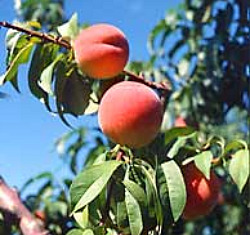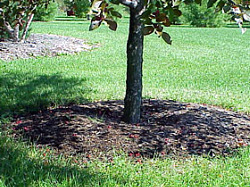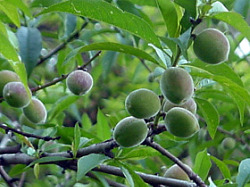
When thinning, favor fruits growing on the outside and top of the tree where they will get the most sunshine and develop the best flavor.
It's summer and fruit trees in your yard are probably putting on lots of new growth, and, hopefully, the fruits are sizing up nicely. This is the time of year to be on top of fruit tree care so you can avoid insect, disease, and weather-related problems. Here are some things to keep in mind when caring for your fruit trees this summer.
• Check Them Often – Inspect your fruit tree bark, branches, leaves, and developing fruits often. Look for signs of insects and diseases and apply the appropriate organic controls. Check out the article, Healthy Home Orchards, at the end of this story for more on controlling specific insects and diseases in your orchard. It's usually easier to control pests if you act before or just as they are getting established, than to control them after they have caused lots of damage.
• Keep Them Watered – Fruit trees need water to size up their fruit properly. It's best to water deeply and infrequently rather than shallowly and frequently. Water trees on sandy soils every 1 to 2 weeks providing enough water so it sinks 2 feet into the soil. On clay soils, water every 2 to 3 weeks. The frequency will vary depending on weather conditions. Water less during rainy periods and more during droughts. For young trees, make a moat around the base of the tree so the water stays in the root zone. On older trees, water at the drip line of the tree.

Mulch to protect the trunk from mowers and string trimmers and to keep weeds at bay.
• Control Weeds with Mulch – Keep the base of your fruit trees weed free. Spread a 2- to 3-inch thick layer of organic mulch, such as pine straw or bark mulch, over the root zone but keep it a few inches away from the trunk. The mulch serves a number of functions. It creates a no- mow ring around the tree trunk so you'll be less likely to damage it with a lawn mower or string trimmer. On younger trees, mulch reduces weed competition and keeps the soil moist longer, reducing the need to water. Organic mulch also breaks down gradually, providing organic matter to the soil.
• Fertilizing Trees – How much you fertilize your fruit tree depends on how well it's growing. Adding compost around the base of young fruit trees (but a few inches away from the trunk) and at the drip line of older trees, is always a good practice. Base any other fertilizing on a soil test and the growth of your tree. For example, for non-bearing apple trees, yearly shoot growth should be between 24 to 36 inches; for pears, 12 to 26 inches; and for peaches, 16 to 24 inches. In fruit-producing apple trees, shoot growth should be between 12 to 24 inches; for pears, 6 to 12 inches; and for peaches, 10 to 18 inches. The soil pH for most fruit trees should be around 6.5 to 7.0. It's best to apply fertilizer early in the summer season. Don't fertilize in late summer or you'll stimulate new growth which may be winter injured and you'll delay the tree hardening off for winter.

Thin peaches and nectarine fruits when they are about 1-inch in diameter to 3 to 5 inches between fruits.
• Thin Your Fruit – Most fruit trees produce more fruit than the tree can support. While the tree will naturally shed some fruit during an early summer drop, you may need to thin more than nature does. Thinning fruits eliminates diseased or insect infested fruits, reduces fruit load, prevents branches from breaking during the summer from the heavy weight of the excessive fruits, and prevents alternate year bearing which is common on some fruit trees varieties. Wait until after the natural drop to thin your fruits. The fruits should be about 1-inch in diameter when you're thinning them. Leave the largest, healthiest looking fruit on the tree, and favor fruits located towards the outside and upper portions of the tree. These will receive the most sun and produce the best quality fruits. If it's a light bearing year, thin less. Thin more during heavy fruit set years.
Here are some spacing guidelines for thinning fruits on common tree fruits.

Summer pruning removes unwanted water sprouts which can crowd the center of a fruit tree.
• Summer Pruning – While most pruning of fruit trees is done in the late winter, some can be done in the summer as well. Summer pruning can eliminate any dead, diseased, or broken branches. You can also remove excessive vegetative growth and stimulate more fruit bud initiation. Before mid-summer, prune off any new branches that are growing from the base of the tree (suckers) or straight up from horizontal branches (water sprouts). These branches won't form fruits and will tend to crowd other branches, increasing the incidence of disease and insect problems. Pinch back other new growth to stimulate more fruit buds to form in the future.
• Spread the Branches – On young fruit trees, encourage strong branch or crotch angles by spreading the branches. Branches spread to a 45 degree angle or greater with the trunk will be stronger and produce less vegetative growth and more fruit. You can use wooden spreaders placed between narrow-angled branches to slowly force them apart, or take fishing line with weights attached and tie them to ends of smaller branches needing to grow more horizontally. After one year the branches will be naturally be growing at the right angle and the spreaders can be removed.
More Stories on Summer Fruit Tree Care:Pruning Fruit Trees
Fruit Tree Care
Healthy Home Orchards
 Charlie Nardozzi is an award winning, nationally recognized garden writer, speaker, radio, and television personality. He has worked for more than 30 years bringing expert gardening information to home gardeners through radio, television, talks, tours, on-line, and the printed page. Charlie delights in making gardening information simple, easy, fun and accessible to everyone. He's the author of 6 books, has three radio shows in New England and a TV show. He leads Garden Tours around the world and consults with organizations and companies about gardening programs. See more about him at Gardening With Charlie.
Charlie Nardozzi is an award winning, nationally recognized garden writer, speaker, radio, and television personality. He has worked for more than 30 years bringing expert gardening information to home gardeners through radio, television, talks, tours, on-line, and the printed page. Charlie delights in making gardening information simple, easy, fun and accessible to everyone. He's the author of 6 books, has three radio shows in New England and a TV show. He leads Garden Tours around the world and consults with organizations and companies about gardening programs. See more about him at Gardening With Charlie.
 Victory Seed Company has all the seeds you want for your best garden in 2024.
Victory Seed Company has all the seeds you want for your best garden in 2024.
For 25 years, the family-owned Victory Seed Company has provided the highest quality vegetable, herb and flower seeds to families across the country. We are passionate about providing you the best seeds available that give excellent germination, robust plants, and the harvest you want. With a catalog of over a thousand varieties, we have everything, and our prices are the kinds that we'd want to pay. We have hundreds of yesterday's heirloom vegetables, as well as today's award winning hybrid selections. Get to know us by visiting our website and browsing through our online vegetable seed catalog.